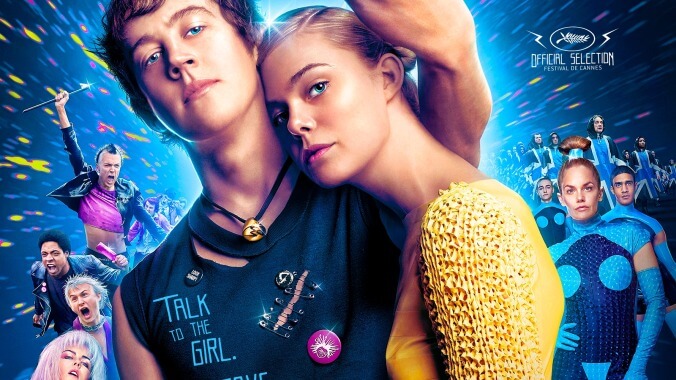Wannabe punks meet real aliens in the vapid Neil Gaiman adaptation How To Talk To Girls At Parties
Film Reviews Movie Review
How To Talk To Girls At Parties, John Cameron Mitchell’s fourth feature and first in seven years, tries to be many, many things. It’s a coming-of-age tale about wading through the murky waters of adolescent sexuality. It’s a painfully sincere love story between a sensitive boy and a mysterious girl from out of town (or, in this case, out of planet). It’s a period piece following punk rock’s first wave and its subsequent cultural takeover. It’s a ’70s sci-fi homage, complete with aliens that look like us and live next door, and a thinly veiled political metaphor. It’s a fashion show. It’s a tribute to individuality. It’s everything and nothing at once.
There’s some abstract value in this kind of ambition, but one would suspect it would at least lead to a film that’s overstuffed with ideas, even if they’re not so interesting. Instead, How To Talk To Girls At Parties mostly scratches at one mildly clever idea, trying, and ultimately failing, to draw blood. The idea in question involves an intergalactic culture clash between Zan (Elle Fanning), a young alien on tour of Earth, and Enn (Alex Sharp), a suburban wannabe punker who makes zines and stirs up an insignificant ruckus with his two friends (A.J. Lewis and Ethan Lawrence). Zan breaks free from her conformist colony to spend a couple days with Enn because she wants to “learn about the punk.” Misunderstandings arise when Enn and his friends first meet the aliens at a stash house they believe to be a performance art party; later, they compound when Enn believes Zan’s curious behavior can be attributed to an American death cult. The verbal and social misreadings eventually culminate with Queen Boadicea (Nicole Kidman, having as much fun as possible with a caricature), a maternal Vivienne Westwood-esque figure in the community, thrusting Zan onstage where she wows a basement crowd with an improvised punk tune that doubles as an alien training manual.
The various cultural miscues coupled with a cosmic-fish-out-of-water teen love story could have been cute enough, but Mitchell (Hedwig And The Angry Inch, Rabbit Hole) and co-writer Philippa Goslett make the unfortunate choice to “world build,” mostly by examining the sociopolitical foundation of the alien colonies. Essentially, Zan’s rebellion sparks social unrest among the extraterrestrial tourists and catalyzes self-examination about their life cycle. Despite the deliberate vagueness of the alien mythology and the sheer incoherence of what constitutes their politics, Mitchell and Goslett spend a ridiculous amount of time on the Star Trek-esque minutiae of it all. Perhaps it’s funny? Or maybe audiences will want to suss out the logical ties beneath a confused surface? It’s difficult to invest in any of it when personalities are defined by S&M-inspired costumes rather than discernible characteristics, though credit is due to actors Tom Brooke, Ruth Wilson, and Matt Lucas for their last-ditch attempts to provide three dimensions to their respective roles. The sketchy characterizations render any political parallels dead on arrival. There’s a Brexit metaphor at play, but anything resembling commentary can be summed up by the image of aliens wrapped in the British flag jumping off a bridge.
Granted, there’s an obvious need to expand on Neil Gaiman’s original 18-page short story, but Mitchell mainly focuses on beefing up the cosmetics, notably the punk community in Croydon. The director’s wide-eyed, glamlike spin on punk doesn’t strive for verisimilitude, and while that’s certainly a valid choice, it also strongly clashes with the fiercely countercultural spirit it tries to appropriate. Punk in How To Talk To Girls At Parties mostly amounts to inchoate rage without any edge, an outlet for disaffected youth in which the actual music is a complete afterthought, but it’s also a resonant symbol of freedom in the face of conventional society. There’s something to that notion, especially when punk hit the mainstream, but Mitchell never commits to that take beyond a melancholic monologue about the good ol’ days courtesy of Queen Boadicea. Instead, punk is a colorful backdrop and a life credo, an insincere pose and a sincere reaction to the world, a total performance and an authentic lifestyle. Again, it’s possible to pull that off, but it requires a certain amount of finesse, which doesn’t exist in a film that treats the movement both glibly and self-seriously. (However, there is exactly one good joke involving the band Pere Ubu that deserves to go unspoiled.)
“There are contradictions in your metaphor, but I am moved by it,” Zan tells Enn at one point, and while that’s a testament to teenage verbiage, it also scans as a mea culpa for the film’s internal inconsistencies. How To Talk To Girls At Parties wants to be a tossed-off romp that coasts on its energy, but it also packs in needless threads that merely paw at Serious Concepts. It can’t rely so much on aesthetics because there isn’t much style to speak of. (With the exception of the costume design, courtesy of Sandy Powell, the film looks amateurish at best and dreadful at worst, especially the cheap effects and the unnecessary iTunes-visualizer-inspired animated interludes.) By the end, How To Talk To Girls At Parties adds up to a forgettable, blandly superficial fairy tale that attempts to plumb shallow lakes of insight. To quote the Sex Pistols, “Oh we’re so pretty / Oh so pretty / We’re vacant.”